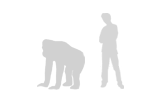
CREATURE-PEDIA
Orangutan




Fun Fact
The name Orangutan means “Person of the Forest”.
The orangutans are the two exclusively Asian species of extant great apes. An orangutan has a large, bulky body, a thick neck, very long, strong arms, short, bowed legs, and no tail. It is mostly covered with long, reddish-brown hair and grey-black skin. Adult males have large cheek flaps to show their dominance to other males. The cheek flaps are made mostly of fatty tissue and are supported by the musculature of the face. Mature males' throat pouches allow them to make loud calls. Females typically stand up to 3 ft 9 in tall and weigh around 82 lb, while adult males stand up to 4 ft to 6 in tall and weigh 165 lb. A male orangutan has an arm span of about up to 6.6 ft. Orangutan hands are similar to human hands; they have four long fingers and an opposable thumb. However, the joint and tendon arrangement in the orangutans' hands produces two adaptations that are significant for arboreal locomotion. Biologists have described their habitats as inaccessible, swamp logged, leech-laden tropical forests. The islands of Borneo and Sumatra have vast mountain ranges and Orangutans are rarely seen in elevations that exceed 500 meters. Orangutans are opportunistic foragers, and their diets vary markedly from month to month. Fruit makes up 65–90% of the orangutan diet, and those with sugary or fatty pulp are favoured. Ficus fruits are commonly eaten and are easy to harvest and digest. Lowland dipterocarp forests are preferred by orangutans because of their plentiful fruit. Bornean orangutans consume at least 317 different food items that include young leaves, shoots, bark, insects, honey and bird eggs. Orangutans build nests specialized for both day or night use. These are carefully constructed; young orangutans learn from observing their mother's nest-building behaviour. In fact, nest-building is a leading cause in young orangutans leaving their mother for the first time. From six months of age onwards, orangutans practice nest-building and gain proficiency by the time they are three years old. Doing this increases the stability of the nest and forms the final act of nest-building. In addition, orangutans may add additional features, such as "pillows", "blankets", "roofs" and "bunk-beds" to their nests. Males mature at around 15 years of age. However, they only develop the distinctive cheek pads, pronounced throat pouches, long fur, or long-calls when they are between 15 and 20 years old. The development of these characteristics depends largely on the absence of a resident male. Males without them are known as unflanged males in contrast to the more developed flanged males.

